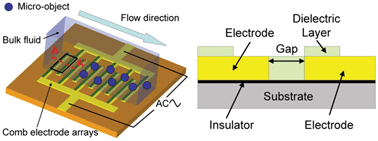A novel ac electrokinetic microfluidic driver based on alternating current electro-osmosis flow induced by asymmetrically capacitance/chemistry-modulated microelectrode arrays has been successfully developed and demonstrated. Asymmetric capacitance modulation (ACM) is made of comb electrode arrays and parts of individual electrode surfaces are modulated/deposited with a SiO2 dielectric layer. This proposed design can be utilized to shift the optimal operation frequency of maximum velocity to a higher frequency to minimize electrolytic bubble generation and enhance micropumping performance. The pumping velocity, described in this paper, is measured via the tracing of microbeads and is a function of applied potential, signal frequency, buffer concentration, and dielectric layer thickness. A maximum pumping velocity up to 290 μm s−1 in 5 mM buffer solution with the applied potential of 10 Vpp is observed in our prototype device, and the estimated maximum flow rate is up to 26.1 μl h−1. This is the first successful demonstration regarding bubble-free ac electrokinetic micropumping via such asymmetrically capacitance-modulated electrode arrays. Design, simulation, microfabrication, experimental result, and theoretical model are described in this paper to characterize and exhibit the performance of the proposed novel bubble-free ac electrokinetic microfluidic driver.

You have access to this article
 Please wait while we load your content...
Something went wrong. Try again?
Please wait while we load your content...
Something went wrong. Try again?


 Please wait while we load your content...
Please wait while we load your content...